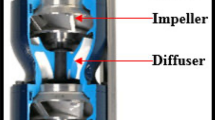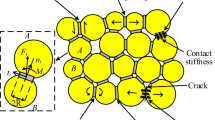Abstract
Fault caused by earthquake is harmful to buried pipelines. Long-distance transportation pipelines will inevitably cross the seismic fault zones. In this paper, a numerical simulation model of X80 pipeline under reverse faulting with a crossing angle of 60° was established. Damage evolution mechanism of buried steel pipeline was analyzed. Effects of internal pressure and diameter-thickness ratio on the stress, strain and displacement of pipeline were discussed. The results show that the buckling phenomenon is more severe in the hanging wall than that in the footwall for reverse fault. For non-pressure pipeline, local collapse occurs on the compression side. When the pipeline wall buckles, the axial stress is released, and high-stress is mainly concentrated on the collapsed position. For pressure pipeline, the internal pressure aggravates the buckling degree. Then, wrinkles appear on the compression side. The results can provide a reference for anti-seismic construction, repair and maintenance of buried pipeline.
Similar content being viewed by others
References
J. Zhang, H. Zhang and L. Zhang, Buckling response analysis of buried steel pipe under multiple explosive loadings, Journal of Pipeline Systems Engineering and Practice, 11 (2) (2020) 04020010.
P. Vazouras, S. A. Karamanos and P. Dakoulas, Finite element analysis of buried steel pipelines under strike-slip fault displacements, Soil Dynamics and Earthquake Engineering, 30 (11) (2010) 1361–1376.
P. Ni, X. Qin and Y. Yi, Use of tire-derived aggregate for seismic mitigation of buried pipelines under strike-slip faults, Soil Dynamics and Earthquake Engineering, 115 (2018) 495–506.
N. M. Newmark and W. J. Hall, Pipeline design to resist large fault displacement, Proc. of the US National Conference on Earthquake Engineering, Michigan (1975) 416–425.
R. P. Kennedy, A. M. Chow and R. A. Williamson, Fault movement effects on buried oil pipeline, Transportation Engineering Journal of ASME, 103 (5) (1977) 617–633.
B. Dezhkam and A. Z. Nouri, Dynamic response of nanoparti-cle-water pipes buried in the soil subjected to far-fault earthquake using numerical method, Soil Dynamics and Earthquake Engineering, 113 (2018) 174–179.
J. Zhang, Z. Liang and C. J. Han, Buckling behavior analysis of buried gas pipeline under strike-slip fault displacement, Journal of Natural Gas Science and Engineering, 21 (2014) 921–928.
J. Zhang, Y. Xiao and Z. Liang, Mechanical behaviors and failure mechanisms of buried polyethylene pipes crossing active strike-slip faults, Composites Part B: Engineering, 154 (2018) 449–466.
P. Vazouras, S. A. Karamanos and P. Dakoulas, Mechanical behavior of buried steel pipes crossing active strike-slip faults, Soil Dynamics and Earthquake Engineering, 41 (2012) 164–180.
G. Banushi, N. Squeglia and K. Thiele, Innovative analysis of a buried operating pipeline subjected to strike-slip fault movement, Soil Dynamics and Earthquake Engineering, 107 (2018) 234–249.
X. Cheng, C. Ma, R. Huang, S. Huang and W. Yang, Failure mode analysis of X80 buried steel pipeline under obliquereverse fault, Soil Dynamics and Earthquake Engineering, 125 (2019).
M. Fadaee, F. Farzaneganpour and I. Anastasopoulos, Response of buried pipeline subjected to reverse faulting, Soil Dynamics and Earthquake Engineering, 132 (2020).
J. Zhang and J. Xie, Effect of reservoir’s permeability and porosity on the performance of cellular development model for enhanced geothermal system, Renewable Energy, 148 (2020) 824–838.
J. Zhang and Y. Hu, Sealing performance and mechanical behavior of PEMFCs sealing system based on thermodynamic coupling, International Journal of Hydrogen Energy, 45 (43) (2020) 23480–23489.
American Petroleum Institute, Specification for Line Pipe, API/PETRO SPEC 5L-ENGL 2000, Washington, D.C. (2000).
S. Wang, Y. Yin and Y. Men, In-situ test and numerical analysis of skid resistance for micropile to loess landslide, Hydro-geology and Engineering Geology, 37 (6) (2010) 22–26, 32.
A. Liu, Response analysis of a buried pipeline crossing the fault based on shell-model, Ph.D. Dissertation, Institute of Geophysics, China Seismological Bureau (2002).
Acknowledgments
This work is supported by Nanchong science and technology program (NC17SY4018), Open Fund of National Joint Engineering Research Center for Abrasion Control and Molding of Metal Materials (HKDNM201806), and Sichuan Province Science and Technology (21MZGC0155).
Author information
Authors and Affiliations
Corresponding author
Additional information
Jie Zhang received Ph.D. in Mechanical Engineering from Southwest Petroleum University (SWPU) in 2016. He is an Associate Professor of Mechanical Engineering at SWPU. His main research direction is oil and gas pipeline mechanics and safety evaluation, oil and gas equipment strength and service performance, efficient heat transfer technology.
Rights and permissions
About this article
Cite this article
Zhang, J., Chen, Y., Liang, B.F. et al. Damage evolution mechanism of buried pipeline crossing reverse fault. J Mech Sci Technol 35, 71–77 (2021). https://doi.org/10.1007/s12206-020-1206-0
Received:
Revised:
Accepted:
Published:
Issue Date:
DOI: https://doi.org/10.1007/s12206-020-1206-0




